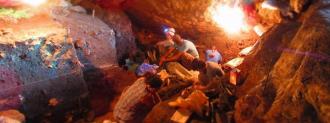Researchers have sequenced an ancient human’s genome using DNA extracted from cave dirt — and not the skeletal remains of the human itself.
It isn’t the first time DNA has been extracted from dirt, but the new technique they used for the first time here could make it easier to produce ancient human genomes from soil in the future — potentially unlocking a new gold rush of discoveries about our past.
Genome sequencing: A genome is a list of all the letters along the DNA ladder (A, G, C, and T) written out in order. Sequencing is the process of creating that list from an actual DNA molecule.
In modern humans, 99.9% of the genome is identical among all people. The differences in the final 0.1% are due to genetic variants or mutations, which can be shared among unique populations of people.
The challenge: A genome is essentially a genetic instruction manual — it determines what an organism looks like, how it functions, and more — so, by sequencing the DNA of ancient humans, we can learn a lot about them.
Scientists have even discovered an entirely new population of ancient humans through genome sequencing.
Traditionally, though, researchers have had to rely on skeletal remains or teeth for ancient human DNA. Because those aren’t exactly plentiful, it’s hard to know what’s “normal” in an ancient human’s genome and what might be a rare genetic mutation.
Environmental DNA: In 2017, researchers proved it was possible to extract human DNA from the dirt in places where ancient humans lived — no remains required.
Now, an international team has sequenced an ancient human’s genome from dirt using the cheapest, fastest technique: shotgun sequencing.
“There’s dirt everywhere!”
Benjamin Vernot
This dirt was pulled from Satsurblia Cave in the nation of Georgia. Based on artifacts found in the cave, such as pottery and tools, archaeologists believe humans started inhabiting it 25,000 years ago.
In 2013, a single human skull fragment, determined to be from a man who lived about 15,000 years ago, was discovered in the cave. That man’s genome was sequenced from the DNA in the bone, but no other human bones have been discovered in the cave since then.
The woman whose DNA has now been discovered in the dirt is believed to have lived in the cave 25,000 years ago, making her part of a previously unknown population of ancient humans.
Understanding ancient humans: The ability to more cheaply sequence the genomes of ancient humans from dirt samples could dramatically increase the number of genetic blueprints researchers have to analyze — opening a window into our past.
“There’s dirt everywhere!” geneticist Benjamin Vernot from the Max Planck Institute for Evolutionary Anthropology, who wasn’t involved with this study, told Science Magazine.
“If you can systematically get DNA from sediment samples, you can study people who lived at many hundreds or thousands of locations — even if they didn’t leave behind their remains,” he continued.
We’d love to hear from you! If you have a comment about this article or if you have a tip for a future Freethink story, please email us at [email protected].






